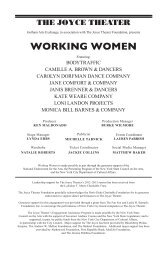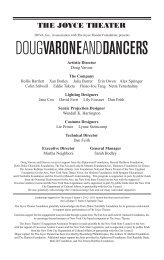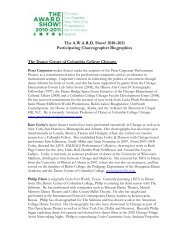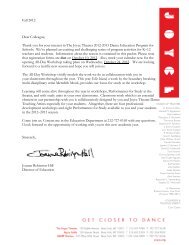Create successful ePaper yourself
Turn your PDF publications into a flip-book with our unique Google optimized e-Paper software.
Some believe that the following centuries of persecution provided the tragedy and trauma that ultimately generated<br />
the deep songs in Spain, whose verses often describe moments of terror or grief from a victim’s perspective.<br />
They view the deep song as a monumental creation by some Gypsy families and clans in and around Jerez and<br />
Seville – a testament, forged in the ghettos beyond the earshot of outsiders.<br />
Other authorities dismiss that gitanista or “Gypsyist” view as a romantic backstory devoid of documentation.<br />
They believe that flamenco simply didn’t exist before it was described in the press around 1850. Instead, they<br />
say that many influences coalesced into flamenco song at that time.<br />
Two later and lighter forms of flamenco song, the bulerías and the tangos, are also associated with Gypsy<br />
genesis. The bulerías is an incessant presence in flamenco today, both in its traditional form and as a rhythmic<br />
framework for catchy popular songs termed cancion or copla that appeal to a wider audience.<br />
Other flamenco songs include the light and lively cantinas group – major key forms including the alegrías, the<br />
mirabrás, the caracoles, and the romeras. The sprawling fandangos group seems to have sprung from the folky<br />
and rhythmic fandangos de Huelva, which was “aggrandized” when sung slowly and freely. This led to the<br />
creation of the serious and often melodramatic fandangos naturales and then to regional variants including the<br />
granaínas, malagueñas, tarantas, cartageneras, mineras and others<br />
Another group are the cantes de ida y vuelta, or round-trip songs, which incorporate melodies that filtered into<br />
Latin America from Spain, acquired a distinctive Latin lilt and sway, and returned in the early Twentieth Century<br />
as the guajiras, vidalitas, milongas and colombianas.)<br />
Other flamenco song forms include the farruca and the garrotín, influenced by folk songs of Catalonia; the serranas<br />
from the mountains of Andalusia; the caña and the polo, Andalusian songs influenced by Gypsy aspects of<br />
the solea; the peteneras, which may reflect surviving Jewish influences, and the tientos, a majestic elaboration of<br />
the tangos.<br />
Great singers of the past include La Niña de los Peines, Manuel Torre, Antonio Chacon, Manolo Caracol, Antonio<br />
Mairena and others. More recent figures were La Fernanda de Utrera, El Chocolate, Terremoto de Jerez, La<br />
Paquera and the revolutionary Camarón de la Isla whose work with guitarist Paco de Lucía shattered the conventions<br />
of the flamenco tradition. Enrique Morente was another singer who mastered the art and then made radically<br />
different music. Among the living masters are Jose Mercé, Carmen Linares, Miguel Poveda, Manuel Moneo,<br />
El Torta and Manuel Agujetas.<br />
Flamenco dance is a way of interpreting all of the art’s rhythmic forms (and recently, some of the free-rhythm<br />
forms). The dance sometimes surges up spontaneously as untrained people feel impelled to respond to the pulse<br />
of a flamenco performance – usually a bulerías. That aspect of flamenco is often seen during the encore segment<br />
of a troupe’s performance, when everyone including the accompanists takes a star turn.<br />
But flamenco dance is above all a highly developed art. It seems to spring from the Spanish earth, recalling the<br />
centuries of Moorish occupation, the simple folk dance forms of the earliest fandangos and verdiales, the dignity<br />
of Spain’s formal court dances, the weight of poverty and oppression seen in the soleá, or the lightness, energy<br />
and sheer joy that still shines in the alegrías.<br />
Over time, flamenco dance evolved toward a greater majesty, as techniques became more complex and the differences<br />
between feminine and masculine dance became codified.<br />
The woman’s dance was more reposed, focusing on the arms and head while the feet smoothly marked the<br />
rhythm. The arms were raised high above the head while the hands turned from the wrist in smooth twisting motions<br />
to further accentuate the expressive line of the arms.<br />
Violent, abrupt movement of the body was rare. The bata de cola – the flamenco dress with a long train – was<br />
introduced. The skirt scarcely moved at all, rarely rising above the ground. The emphasis was on garbo, elegance<br />
and grace.









